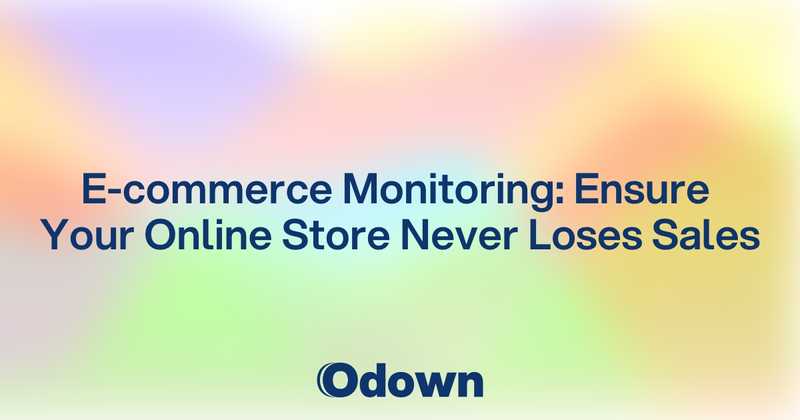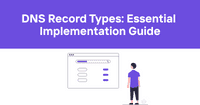E-commerce Monitoring: Ensure Your Online Store Never Loses Sales
It's Black Friday morning. Your traffic is up 500% from normal levels. Everything looks green on your monitoring dashboards. Then you notice something troubling in your revenue reports - despite the massive traffic spike, sales are actually down compared to last year. Your site is technically "up," but something is broken in ways your monitoring isn't catching.
You dig deeper and discover the problem: your payment processor is timing out during checkout, but only under high load. Customers are filling their carts, going through checkout, entering their payment information, and then getting mysterious errors at the final step. They're abandoning their purchases and shopping elsewhere.
This scenario illustrates the fundamental challenge of e-commerce monitoring. Traditional uptime monitoring tells you if your servers are running, but it can't tell you if customers can actually complete purchases. E-commerce success depends on complex workflows that span multiple systems, third-party services, and user interactions that can fail in subtle ways.
Critical E-commerce Monitoring Points: Cart, Checkout, and Payment
E-commerce monitoring must focus on the business-critical workflows that directly generate revenue rather than just technical infrastructure health.
Shopping Cart Functionality Monitoring
Shopping cart operations represent the beginning of the purchase funnel where technical problems can immediately impact revenue. Monitor cart functionality across different user scenarios and device types.
Add-to-cart success rates reveal whether product catalog integration works correctly and whether inventory checks function properly. Failed add-to-cart operations often indicate database performance issues or inventory management problems.
Cart persistence monitoring ensures that users' shopping selections remain available across sessions and device switches. Lost carts due to technical issues create frustrating user experiences that drive customers to competitors.
Cart modification operations like quantity changes, item removal, and shipping option updates need reliable monitoring because cart editing problems often lead to purchase abandonment.
Cross-device cart synchronization becomes critical as users frequently start shopping on mobile devices and complete purchases on desktop computers. Monitor cart sync performance and accuracy across different device types.
Guest checkout versus account-based cart handling requires different monitoring approaches because the underlying data storage and session management patterns differ significantly.
Checkout Process Monitoring
The checkout process represents the highest-value user workflow in e-commerce applications. Every failure during checkout directly translates to lost revenue and frustrated customers.
Multi-step checkout monitoring tracks completion rates at each stage of the checkout process to identify where users encounter problems or abandon their purchases.
Address validation and shipping calculation monitoring ensures that users can enter their shipping information correctly and receive accurate shipping costs and delivery estimates.
Tax calculation accuracy affects final purchase amounts and legal compliance. Monitor tax calculation performance and accuracy across different geographic regions and product types.
Coupon and discount code processing often involves complex business logic that can fail under load or with specific product combinations. Monitor discount application success rates and accuracy.
Checkout form validation provides user feedback about required information while preventing invalid data submission. Monitor validation response times and accuracy to ensure smooth user experience.
Payment Processing Reliability
Payment processing represents the final and most critical step in e-commerce transactions. Payment failures directly cause lost sales and can create compliance and security issues.
Payment gateway integration monitoring tracks response times, success rates, and error patterns across different payment methods and transaction amounts.
Credit card processing success rates vary by card type, issuing bank, and transaction characteristics. Monitor payment success rates across these dimensions to identify optimization opportunities.
Alternative payment method monitoring includes digital wallets, buy-now-pay-later services, and region-specific payment methods that might have different performance characteristics.
Payment security monitoring ensures that payment processing maintains PCI compliance and doesn't expose sensitive financial information through technical failures.
Fraud detection integration monitoring tracks how fraud prevention measures affect legitimate transactions and whether security measures create user friction that impacts conversion rates.
Payment retry logic monitoring reveals how well applications handle temporary payment processing failures and whether retry mechanisms work correctly without creating duplicate charges.
Inventory and Product Availability Monitoring
Inventory management directly affects customer satisfaction and revenue optimization. Monitor inventory systems to prevent overselling while maximizing product availability.
Real-Time Inventory Tracking
Inventory synchronization across multiple sales channels requires monitoring to ensure that product availability information remains accurate as inventory levels change.
Stock level accuracy monitoring compares reported inventory levels with actual product availability to identify discrepancies that could lead to overselling or missed sales opportunities.
Inventory update latency tracking reveals how quickly inventory changes propagate through e-commerce systems. Slow inventory updates can cause overselling or prevent sales of available products.
Multi-location inventory monitoring tracks product availability across different warehouses, stores, or distribution centers that might serve different customer segments.
Reserved inventory monitoring tracks products held in customer carts or pending orders to ensure accurate availability calculations while minimizing cart abandonment due to inventory conflicts.
Product Catalog Health
Product information accuracy affects customer decision-making and search engine optimization. Monitor product catalog data quality and availability.
Product image availability and loading performance directly impact user experience and conversion rates. Monitor image delivery across different device types and network conditions.
Product description and pricing accuracy requires monitoring because incorrect information can create legal issues and customer satisfaction problems.
Search functionality monitoring ensures that customers can find products effectively through site search, category browsing, and filter operations.
Product recommendation accuracy affects cross-selling and upselling opportunities. Monitor recommendation engine performance and click-through rates.
Product page loading performance varies significantly based on product data complexity, image count, and personalization features. Monitor performance across different product types and user segments.
Inventory Integration Monitoring
Third-party inventory management system integration requires monitoring to ensure data synchronization and system availability.
ERP system connectivity monitoring tracks integration health with enterprise resource planning systems that often serve as authoritative inventory sources.
Supplier data integration monitoring ensures that drop-shipping and vendor inventory information remains current and accurate.
Warehouse management system integration monitoring tracks connectivity with fulfillment systems that affect order processing and shipping calculations.
Inventory forecasting system monitoring helps ensure that demand planning and purchasing systems receive accurate sales and inventory data.
E-commerce Performance Optimization for Peak Shopping Seasons
Peak shopping periods like Black Friday, Cyber Monday, and holiday seasons create unique monitoring requirements and optimization opportunities.
Traffic Surge Preparation
Peak season traffic can exceed normal levels by 5-10x, requiring monitoring strategies that account for extreme load conditions and performance scaling requirements.
Load balancing effectiveness monitoring becomes critical during traffic surges to ensure that increased load distributes evenly across available infrastructure.
Auto-scaling monitoring tracks how well infrastructure responds to traffic increases and whether scaling policies activate appropriately without creating resource bottlenecks.
CDN performance monitoring reveals how content delivery networks handle increased traffic and whether static content delivery remains fast during peak periods.
Database performance under load requires specialized monitoring because database bottlenecks often become the limiting factor during traffic surges.
Third-party service capacity monitoring ensures that payment processors, shipping calculators, and other external services can handle increased transaction volumes.
Conversion Rate Optimization
Peak shopping periods provide opportunities to optimize conversion rates through performance improvements that might have minimal impact during normal traffic periods.
Page load speed correlation with conversion rates becomes more pronounced during peak periods when users have less patience for slow-loading pages.
Checkout funnel optimization through performance monitoring can significantly impact revenue during high-traffic periods when small conversion rate improvements translate to substantial revenue increases.
Mobile performance optimization becomes critical during peak periods when mobile traffic often exceeds desktop traffic and mobile users have different performance expectations.
Geographic performance monitoring helps optimize experience for users in different regions who might be accessing your site during local peak shopping periods.
Revenue Protection Strategies
Peak season monitoring focuses on protecting revenue opportunities that might not be recoverable if technical problems cause customer abandonment.
Payment processing capacity monitoring ensures that payment systems can handle transaction volumes without creating delays or failures that cause lost sales.
Error rate monitoring with immediate alerting becomes critical during peak periods when high error rates can quickly translate to significant revenue loss.
Customer support integration monitoring helps ensure that increased support volume doesn't create bottlenecks that affect customer experience and retention.
Fraud detection balance monitoring ensures that fraud prevention measures don't become overly aggressive during peak periods and block legitimate high-value transactions.
Customer Experience Monitoring: From Browse to Purchase
E-commerce monitoring must track complete customer journeys rather than individual technical components to understand and optimize actual user experience.
User Journey Analytics
Complete customer journey monitoring tracks users from initial site visit through purchase completion to identify friction points and optimization opportunities.
Product discovery monitoring reveals how effectively customers find products through search, category browsing, recommendations, and external links.
Product evaluation monitoring tracks how users interact with product pages, reviews, images, and specifications to optimize product presentation for conversion.
Cart and checkout progression monitoring identifies where users encounter problems or hesitation during the purchase process.
Post-purchase experience monitoring includes order confirmation, shipping notifications, and delivery tracking that affect customer satisfaction and repeat purchases.
Performance Impact on Business Metrics
Correlate technical performance metrics with business outcomes to prioritize optimization efforts based on revenue impact rather than just technical metrics.
Page load speed correlation with bounce rates reveals how performance affects customer engagement and site exploration.
Search performance impact on conversion rates helps prioritize search infrastructure optimization based on actual business impact.
Checkout performance correlation with abandonment rates provides clear business justification for checkout optimization investments.
Mobile performance impact on sales helps prioritize mobile optimization based on actual revenue impact rather than just technical metrics.
Personalization and Recommendations
E-commerce personalization systems require monitoring to ensure that customization improves rather than degrades user experience.
Recommendation engine performance monitoring tracks response times and accuracy for product recommendations that affect cross-selling and average order values.
Personalization system monitoring ensures that customized content and pricing display correctly across different user segments and device types.
A/B testing infrastructure monitoring tracks experiment performance and ensures that testing doesn't negatively impact user experience or revenue.
Customer segmentation accuracy monitoring helps ensure that targeted promotions and content reach appropriate customer groups.
Multi-Channel Experience Monitoring
Modern e-commerce often spans multiple channels including websites, mobile apps, social media, and physical stores that require coordinated monitoring.
Cross-channel cart synchronization monitoring ensures that customers can start purchases on one channel and complete them on another.
Inventory consistency across channels prevents overselling and ensures that customers receive accurate product availability information regardless of how they access your store.
Pricing consistency monitoring ensures that promotional pricing and customer-specific pricing display correctly across all channels.
Customer support integration monitoring tracks how technical issues affect customer service interactions and resolution times.
E-commerce monitoring transforms online retail from reactive problem-solving to proactive revenue optimization. Instead of discovering that checkout is broken after customers complain, you identify and fix problems before they impact sales.
The investment in comprehensive e-commerce monitoring pays immediate dividends in increased conversion rates, reduced cart abandonment, and protected revenue during peak shopping periods. You finally get visibility into the technical factors that directly affect your bottom line.
Ready to protect your e-commerce revenue? Odown provides comprehensive e-commerce monitoring that tracks cart functionality, checkout performance, and payment processing alongside traditional uptime monitoring. Combined with our mobile app monitoring capabilities, you'll have complete visibility into customer experience across all channels and devices that drive your online sales.



